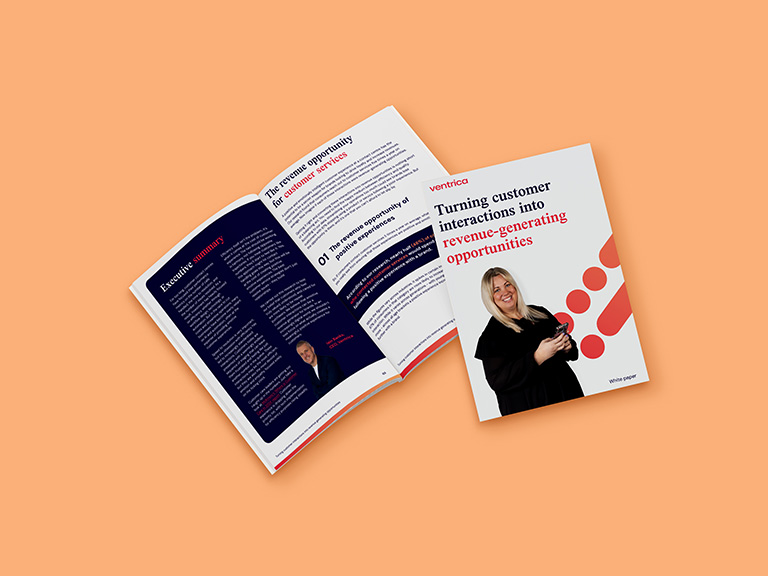Multilingual CX – why it’s foundational, not optional
Language isn’t a nice-to-have—it’s a growth strategy. Multilingual CX builds trust, boosts retention and removes friction. Discover how to scale global service with empathy, clarity and care—without compromising commercial performance.
- Insights, blogs & articles
International customers don’t want to feel like outsiders. And in 2025, they don’t have to – because your competitors are probably investing in seamless, localised services that makes every customer feel seen, heard and understood.
Too many businesses treat multilingual customer experience (CX) like a nice-to-have – a reactive add-on for when things go wrong. But the reality is this – if you want to build trust, scale globally and retain customers in high-value markets, multilingual CX is not optional. It’s foundational.
In this piece, we’ll explore why language matters far, far more than most companies realise, the risks of getting it wrong and how to build a multilingual solution that works.
Why language builds trust
Trust is not just a byproduct of quality; it is the foundation of every meaningful customer relationship. If a customer feels they cannot trust your brand, they will not buy from you. Language is one of the most powerful levers in creating that trust. When a customer is navigating a problem, asking a question or making a purchasing decision, the ability for them to engage in their native language is more than just convenient – it signals care and respect.
Given how English-centric the web is, sometimes native English speakers don’t fully appreciate how big an issue this is. To put it into perspective, imagine you’re browsing a website where the English is OK, but some of the wordings are a bit strange and some things don’t make sense. You might look past this, add something to your cart and go to checkout. When you check out, the “Pay Now” button is in Russian. Would you hand over your credit card details? Probably not.
This is daily life for millions of non-native English speakers navigating difficult digital experiences. Clumsy translations, inconsistent messaging and patchy localisation are often all it takes to erode confidence.
The research out there backs this up and, 75% of customers across 29 countries say they’re more likely to make a repeat purchase when multilingual customer support is provided in their native language. It isn’t just about whether the customer feels that you can understand them, it’s about whether they feel they’re going to have a safe, reliable and trustworthy experience. Clear language builds trust in moments of frustration or confusion. Unclear language or poor language translation shows that you don’t care. And as we’ve said before, if a customer feels you don’t care, they will go and look for someone who does.
This is the real cost of not providing CX; if you don’t speak their language, a customer will feel that you don’t care about them.
The risk of English-only customer experience
It’s a fact that English dominates global business but relying on it as your only or default language is a blind spot. It might seem efficient to centralise support in a single language, but this approach excludes millions of people who might want to buy from you.
Only 17% of people on this earth speak English natively. Of course, many more speak it as a second language, but fluency varies significantly across markets. Expecting your customers to shift to a second language puts the burden of understanding onto them and this creates effort. Effort creates friction and friction erodes loyalty and destroys retention. If a customer is distressed, confused or frustrated, even small linguistic accuracy barriers become big problems and those problems can quickly turn into lost sales, negative reviews or churn.
There is also a social side to this, because English-only CX can send the wrong message. It shows international customers that you’ve decided they’re not worth the investment and that their experience is secondary.
Consider one of the very famous London department store brands. Their customers come from all over the world, and they know it. That’s why if you walk into any of these stores, you will be offeredmultilingual contact through contact centre services in dozens of languages such as Arabic, Mandarin, Spanish, Turkish, etc. This is a strategic choice to create comfort and increase spend among international visitors. When a Chinese-speaking customer can ask a question, receive assistance and complete their purchase entirely in their own language, trust is instant, and conversion follows naturally.
This is why failing to provide multilingual CX is a barrier to growth. It alienates existing customers and undermines other investments you make in customer services. If your CX only speaks one language don’t be surprised when your brand stops resonating beyond one market.

Creating an authentic multilingual support experience – what actually works
Know your language priorities
The first step in providing a meaningful language support strategy is understanding where language coverage will make a difference. We’re not telling you that you need to support every language in the world – no brand does that. But you do need to align language capabilities to commercial reality.
Look at your traffic and sales data. Where are your customers coming from? What markets are you targeting for growth? What language do your support tickets or pre-sale enquiries arrive in? Prioritise languages that:
- Represent a significant share of customer interactions
- Align with your target expansion markets
- Are associated with high-value customer groups.
You should also consider regional fluency. For example, say 5% of your customers come from the Netherlands and 5% from Japan. You’ve got a choice of translating your website into Dutch or Japanese because all your larger markets are covered. 93% of people in the Netherlands have proficiency in English compared to 30% in Japan. English-only assistance isn’t a major barrier in the Netherlands, but it is in Japan. Therefore, translating your website into Dutch would be the wrong thing to do.
It’s rarely as clear cut as this, but the point still stands and that is to use data (not guess) and to make your language choices support strategic decisions.
Localise with purpose, not just translation
It’s crucial that you understand this: translation is not localisation. Too many businesses stop at swapping words, but language carries tone, cultural nuances and cultural weight. To truly resonate with customers in different markets, you need to go deeper.
Effective localisation means adapting your customer service to reflect cultural competency, expectations, norms and sensitivities of each audience. This includes how you structure FAQs, how formal or informal your tone is, how you frame apologies and even how quickly customers expect responses. What feels friendly in the US, might be too casual in Japan. A direct explanation in English might need to be softened or restructured entirely in Arabic or Korean.
Certain cultures express politeness differently. In German, trust is built with clarity and directness, but in Japanese, indirect phrasing and hierarchy matter. If your translated support content ignores this, it will sound robotic or even disrespectful.
Localisation also includes adapting content formats, symbols, date/time formats and contact options. For example, do your help articles include phone numbers with the right country codes? Are your office hours shown in the local time zone, so you don’t have someone in Indonesia trying to call you when it’s 3am your time? Is your live chat manned when customers in that region are online? Are you telling people in Saudi Arabia that you’re available Monday to Friday, when they work Sunday to Thursday?
Done well, localisation removes friction, which again, is the enemy of loyalty and retention. It helps the customer feel like your business is not just available in their language but rather, that it is operating with their reality in mind.
Choose the right channels
An often-overlooked aspect of language support is ensuring the right channels are offered to the right people. For example, in China, WhatsApp, Facebook, etc are non-existent because everybody uses WeChat. If you are trying to offer WhatsApp support to Chinese customers, you are wasting your time. This also goes beyond technical limitations. For example, in Japan, people prefer to call or fill out a structured web form rather than live chat and they place high importance on clear etiquette and structured replies.
Your support channel strategy should reflect how people naturally engage. Don’t assume live chat is universal. Don’t assume that your customers can reach you on WhatsApp or online. Don’t invest in voice support for a market where people prefer text-based communications.
Channel choice also affects staffing. It isn’t enough to translate a live chat widget, if the chatbot can’t deal with the enquiry, passes it onto a human to deal with it and nobody speaks that language. This is where a blended approach, like combining native-speaking agents with AI real-time translation translation tools, can help you extend coverage without compromising quality.
The goal here is not to offer every channel in every language. It’s to offer the right channels, for the right people, in the right way.
Train your team, even in English
Multilingual CX is about how clearly and empathetically the message is delivered and not just about what language it’s delivered in. This starts with training your team to communicate effectively, even in English. Why? Because most “international English” support is delivered by native speakers to non-native speakers which means that clarity, tone and simplicity are essential.
Many businesses get this wrong. They assume that if both the agent and the customer speak English well enough, that’s sufficient. In practice, support interactions often break down not because of what is said, but how it is said. Cultural references that don’t translate, or overly technical phrasing or idioms that might be natural to a native speaker from a particular region, but completely alien to a non-native speaker thousands of miles away, can alienate and exclude a potential customer – even if their English is good enough for them to be able to understand most of what the agent says.
Focus your agents’ training on speaking clear, neutral English that avoids slang or idioms. Active listening and repetition to confirm understanding and writing for clarity in live chat and email are essential, as is knowing when to look to escalate to native-language support.
Even if you offer support in 7 languages, it’s a far bet that English is always going to be your fallback. But if you communicate in English in the right way, this shouldn’t feel like a compromise. Speaking clearly and concisely to your customers isn’t a downgrade but rather a core component of good, respectful multilingual CX.
Top multilingual support pitfalls to avoid
Building a truly effective language support strategy takes more than good intentions. Many businesses fall into the trap of treating languages like an afterthought as if it is something to bolt on rather than design for. Here are some common mistakes to avoid:
Machine translation sometimes doesn’t work well
Just using tools like Google Translate is a good way to potentially embarrass yourself. Machine translation tools like Google Translate can be useful in a pinch, but it will miss nuance, context and tone, especially in customer support, where empathy and clarity are so important. At best, it sounds robotic. At worst, it doesn’t make sense, or it offends. If you aren’t reviewing translations properly, you aren’t localising and you’re just risking your reputation.
Consider the following. The phrase “I saw the email” could be translated into French like this: “J’ai vu l’email”. This means – “I saw (read or noticed) the email.” It could also be translated like this: “J’ai scié l’email”. This literally means “I sawed the email in half (like a piece of wood)”.
Even a beginner level speaker probably wouldn’t make this mistake, much less a native speaker. This is the danger of relying on context-blind translation from machines. Accuracy is not optional in this case and it’s the difference between leaving your customer feeling like they were understood or feeling like they’ve contacted a parody account.
“We support Spanish/German/Dutch/Chinese/Japanese but only by phone and during UK business hours”
Limited channel and time zone availability defeats the purpose of multilingual support. If you are telling your Indian customers that they can only speak to you between 9am and 4pm UK time by calling a UK phone number, you are signalling that their needs are unimportant to you.
Multilingual CX only works when it’s delivered on the channels your customers prefer, at the time that makes sense for them. Use your tools wisely—for example, many platforms now support live chat in multiple languages, helping to streamline your operations and gather real-time feedback to continuously improve your service.
“We don’t get many foreign language queries”
This is a self-fulfilling prophecy. If your website, contact options and support pathways are all in English (and yet you sell internationally), international customers probably won’t bother contacting you. They’ll drop off silently, buy elsewhere, but will never tell you why.
Just because you aren’t hearing from them very often doesn’t mean that they aren’t interested. Instead, it probably means that they don’t feel welcome.
Multilingual CX as a strategic differentiator
Language is not a functional checkbox any more. Language is a strategic lever. In saturated markets where product and price are no longer enough to stand out, customer experience becomes hugely important. Language is one of the most immediate, visible ways to show that you understand your customers, not just demographically, but also emotionally and contextually.
Offering multilingual support signals that you value your global audience. It removes friction from the buying journey and builds trust in moments that matter. And when it’s done right, it doesn’t just improve CX, it drives measurable commercial returns; higher conversion, stronger retention and greater share of market.
Your competitors may still be stuck offering English-only service windows and copy-paste translations. Their loss is your opportunity. Thoughtful, localised, high-empathy multilingual CX is a competitive edge.
How Ventrica enhances your multilingual support strategy
At Ventrica we don’t treat multilingual as an add-on; it’s built into how we deliver service, across strategy, talent, operations and technology.
We provide:
- Native-level support across a wide range of European and global languages
- Channel fluency. Not just linguistic fluency; we match the right languages to the right platforms, from voice to live chat to social
- Local cultural context that is embedded into every interaction, because translation alone isn’t enough
- Scalable delivery that grows with you, whether you’re expanding into one region or fifty
We can help you build, scale and optimise your multilingual CX offering in a way that’s commercially strategic as well as cost-effective. If you’re ready to turn language into loyalty, let’s talk.

Ray Biggs
Chief Operating Officer
